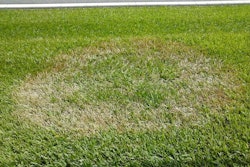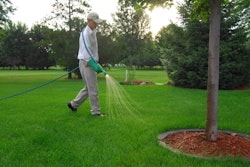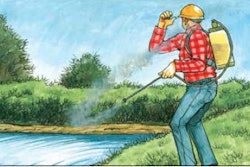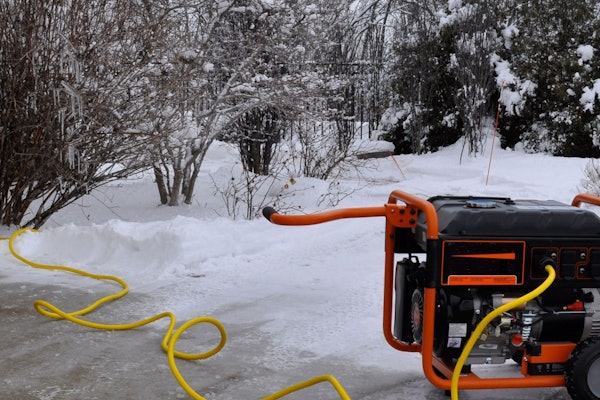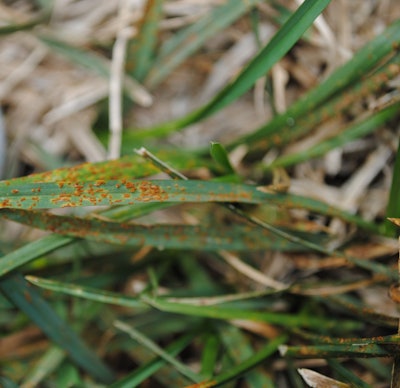 Rust is a fall disease of Kentucky bluegrass or perennial ryegrass, infecting turf that is slow-growing from limited irrigation and/or nitrogen.
Rust is a fall disease of Kentucky bluegrass or perennial ryegrass, infecting turf that is slow-growing from limited irrigation and/or nitrogen.Photo: Bayer
While weeds are ugly and insect pests can be destructive nuisances, some of the most severe turf damage is caused by turf disease. If your client’s lawn suffers from disease, you must be prepared to attack it promptly. The first step is to figure out what disease you’re dealing with. This can be the most daunting task of pest control, and is the reason many landscape contractors are reluctant to offer chemical services.
If you can’t figure out precisely what’s infecting turf, consult the nearest university in your state or your county extension agent. These experts can alert you to current problems in your region and advise you on a course of treatment.
In the meantime, here is a list of common diseases that can help you identify the problem yourself or at least provide you with enough answers to help you describe the conditions and symptoms to someone who can. Remember that the correct diagnosis is the key to solving the problem.
Common diseases
Diagnosing diseases is a process of elimination, and it takes practice. The more you do it, the more familiar you become with the signs and symptoms. While there are more than 100 diseases that can potentially harm turf, these are some of the most common:
- Necrotic ring spot. One of the most common diseases found in Kentucky bluegrass, necrotic ring spot attacks turf’s roots, rendering them useless to absorb water. Eventually, turf withers and dies due to moisture stress. Look for circles of wilted turf. Sometimes the circles have healthy turf in the center, creating what is referred to as a “frogeye.” Usually, weather conditions are hot and humid when turf breaks out with this disease. To treat it, apply a slow-release nitrogen fertilizer and follow up with light and frequent irrigation.
- Powdery mildew. Another threat to Kentucky bluegrass, powdery mildew usually doesn’t cause serious damage. But it’s not pretty to look at: This disease deposits a powdery white substance on leaves. It attacks turf growing in shaded areas, usually during times of increased humidity. Your best bet for dealing with this disease is to replace infected turf with a more shade-tolerant species or variety.
- Red thread. Many turfgrasses can suffer from red thread, including ryegrasses, bentgrasses, Kentucky bluegrass and some warm-season grasses, but it’s especially hard on fine-leaved fescues. Initially, look for a rapid decline of leaves and some browning. But you’ll also see “red threads” of mycelium sticking up from the leaf tips. Red thread often develops during cool (60 degrees to 75 degrees) wet weather or when it is cool and humidity is high. To treat it, withhold irrigation until wet, cool weather subsides and add a nitrogen fertilizer to your maintenance routine. You can control current outbreaks with fertilizer, lime and fungicide.
- Rust. Rust can appear on Kentucky bluegrass and perennial ryegrass. Look for reddish-brown, orange or dark pustules on turf blades. However, you might first notice “rust” on your shoes or equipment, as the spores will rub off on them when you cross turf. Occurring generally late summer to late fall, depending on your climate, rust is usually not a serious problem for turf and requires only an application of fertilizer.
- Stripe smut. Again, Kentucky bluegrass can be hit hardest by this disease, but it also attacks many other turfgrasses. Initially, look for turf to appear lighter green to yellow. Next, infected turf will take on a striped appearance, with gray or lighter green stripes on leaves. Eventually, the fungi will cause the epidermis to erupt in black smut spores. The injured blades die shortly thereafter. Stripe smut will likely occur during times of cooler weather (spring and fall). Preventive fungicides are available that will control stripe smut. Make applications in late fall or early spring.


